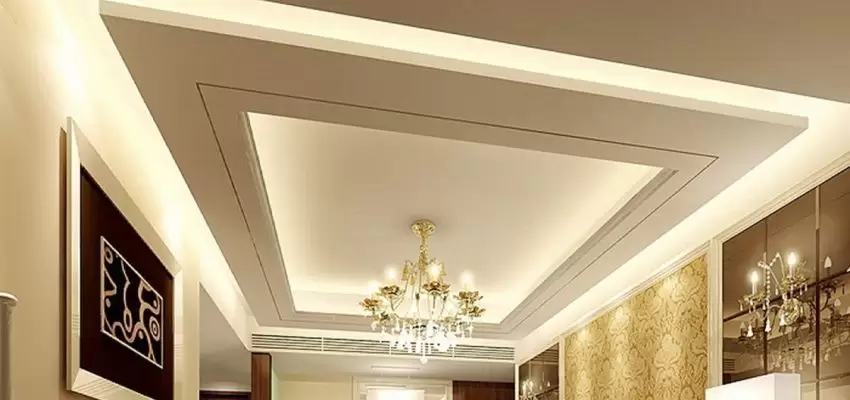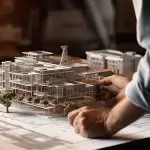False ceilings, also known as drop or suspended ceilings, are secondary ceilings installed below the main structural ceiling in a room. They create an empty plenum space between the two ceiling levels that can conceal infrastructure like ductwork or wiring. False ceilings have also become an important interior design element using various materials and styles. This article will provide an in-depth overview of the different types of false ceilings, the materials used to create them, and their many benefits in residential and commercial spaces.
Post your Requirement
| Term | Meaning |
| False Ceilings | False ceilings, also known as dropped ceilings or suspended ceilings, are secondary ceilings installed below the main ceiling of a room. They are often used for aesthetic purposes, to hide wiring, pipes, and ductwork, or to improve acoustics and insulation. |
| False Ceiling Contractors | False ceiling contractors are professionals or companies specialized in the installation, repair, and maintenance of false ceilings. They provide services such as design consultation, material selection, installation, and customization based on client requirements. |
| False Ceilings Types | False ceilings come in various types, including:
These are just a few examples, and there are many other types available, each with its unique features and benefits. |
Types of False Ceilings
There are five main types of false ceiling systems and designs:
1. Gypsum Board False Ceilings:
This very common false ceiling uses gypsum board panels attached to a metal frame and suspended from the main ceiling using wires or rails. Gypsum false ceilings create a smooth, continuous surface and canvas to apply various paints or wallpaper finishes.
2. Wooden False Ceilings:
Wood planks, panels, or cellular ceiling tiles create stunning warm, and natural-looking false ceilings. Wood materials like pine, cedar, or oak can have stained, painted, varnished, or laminated finishes. Concealed lighting between planks produces dramatic effects.
3. Metal False Ceilings:
Aluminum, steel, or other metal plates fastened to a suspended grid comprise the metal false ceiling. Perforated metal tiles help absorb sound while providing an industrial-chic look. The system allows accessibility to the plenum space.
4. Fiber and Mineral Fiber False Ceilings:
Fiber ceiling tiles contain materials like cellulose, fiberglass, or mineral wool. They have sound-dampening qualities and come covered with vinyl, fabric, or ceramic to achieve different textures and patterns. The lightweight modular tiles install quickly.
5. PVC, Plastic, and Vinyl False Ceilings:
PVC or plastic ceiling panels attach to subframes on walls and ceilings to create shiny, modern-looking false ceilings. The waterproof panels are easy to clean and mold-resistant. 3D patterns and backlighting create cool visual effects.
False Ceiling Materials:
Various materials see use in the fabrication of false ceiling systems, including:
- Gypsum Board– Made of compressed gypsum between paper sheets. Lightweight and easily customizable using paints.
- Metal– Aluminum, galvanized steel, copper, and stainless steel sheets deliver sleek, industrial designs.
- Wood– Natural material sourced from forests and plantations. Available in planks, veneers, prints, slats, or cellular panels using pine, cedar, oak, and more.
- PVC/Plastic– Vinyl tiles and PVC plastic panels offer glossy waterproof finishes that resist moisture damage. Great for basements or bathrooms.
- Mineral Fiber– Inorganic glasswool or rockwool panels made from natural ores, sand, and recycled materials are lightweight and sound-absorbing.
- Fiberglass– Glass fiber-reinforced plastic materials allow easy installation of decorative panels. Durable yet flexible if impact occurs.
Benefits of False Ceilings
Installing a false ceiling delivers multiple advantages, including:
- Increased Space: The plenum zone between the main and false ceilings creates a conduit space for infrastructure like electrical wiring, ductwork, and plumbing unseen from below. This expanded overhead space wouldn’t exist without a lowered secondary ceiling.
- Soundproofing: False ceilings constructed of sound-dampening materials like fiber/mineral wool, cork, or felt limit echo and ambient noise transfer between floors or adjacent rooms.
- Thermal Insulation: The layer of air trapped between primary and false ceilings adds insulating value. This saves energy by better regulating indoor temperatures and reducing costs for heating and cooling.
- Aesthetic Appeal: False ceilings allow limitless design choices with different artistic styles, materials, finishes, colors, lighting, and incorporated architectural elements that match intended moods and decor.
- Concealing Infrastructure: The plenum space above a false ceiling neatly hides necessary building infrastructure like wiring, ducts, pipes, and sprinkler systems otherwise exposed on structural ceilings. This creates cleaner sight lines.
- Increased Ceiling Height: In spaces with low ceiling heights, a false ceiling installed higher above the floor line creates the perception of a taller room.
- Moisture Protection: Waterproof false ceiling materials like vinyl, PVC panels, or moisture-sealed tiles protect rooms below from water damage caused by leaks in the concrete ceiling slab.
- Quick Installation: Modular drop ceiling systems consisting of lightweight tiles suspended on a grid framework see rapid assembly. Accessibility to the plenum zone later remains simple.
- Enhanced Indoor Air Quality: False ceilings allow accommodating returns and ducts for HVAC systems circulate filtered air. Contaminants get diluted with adequate ventilation.
- Added Property Value: The functionality and visual appeal of detailed false ceilings make interior spaces more attractive to potential home buyers or commercial tenants, increasing resale value.
False ceilings not only enable the conception of stylish designs using diverse materials but also provide enhanced utility. The plenum space offers expanded capacity to run mechanical systems while insulation reduces sound transmission and heat loss. For these reasons and easy maintenance access above panels, false ceilings have become a standard component of contemporary construction.
Conclusion
False ceilings offer abundant design flexibility using various panel materials from gypsum board to metal, wood, plastic, and mineral fiber. Leading benefits range from increased ceiling height and infrastructure capacity to soundproofing, decorative appeal, and concealed moisture protection. By understanding the types, constituent materials, and multifunctional upside of quality false ceilings, architects and builders can take full advantage of these useful secondary ceiling systems in future projects.























Post A Comment